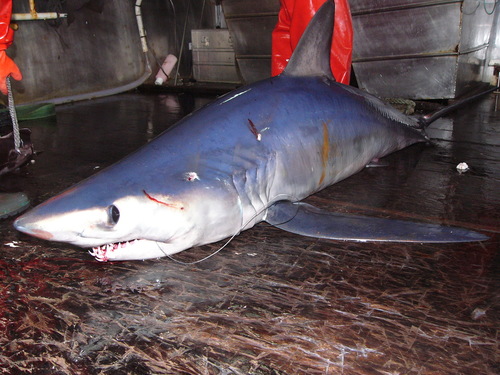
Longfin Mako Shark
The Atlantic bluefin tuna (Thunnus thynnus) is a highly migratory, large pelagic fish renowned for its size, speed, and commercial value. This apex predator plays a crucial role in the marine ecosystem. It is one of the most sought-after fish in the world, especially in the sushi market.
20 30 years
Lifespan
430 cm
Length
Endangered
Conservation Status
70 km/h
Swimming speed
Carnivorous
Diet
Highly Migratory
Migration
Appearance Overview
The Atlantic bluefin tuna is a large, torpedo-shaped fish with a metallic blue-black back and a silvery-white belly.
Color
Dark metallic blue on top, silvery-white underside
Body Shape
Torpedo-shaped, streamlined
Fins
Two dorsal fins, the first depressible; small finlets behind second dorsal and anal fins
Length
Up to 13 feet (4 meters), commonly 6.5 feet (2 meters)
Weight
Up to 2,000 lbs (900 kg), commonly 550 lbs (250 kg)
Diet
Carnivorous, feeding on a variety of fish, squid, crustaceans, and eels.
Feeding Behavior
Highly active predator, using speed and agility to hunt. They can dive deep and often feed cooperatively, herding prey.
Social Behavior
Forms large schools, especially during migration and spawning. Schools can be mixed with other tuna species.
Commercial Relevance
Extremely high value, particularly in sushi and sashimi markets, where a single fish can fetch hundreds of thousands of dollars.
Conservation measures
Subject to international fishing quotas, catch limits, and monitoring programs managed by organizations like ICCAT. Efforts to reduce bycatch and improve fishing practices are ongoing.
Status
Endangered (Varies by population segment; some are critically endangered)
Threats
Overfishing is the primary threat. Historical overfishing severely depleted populations. Climate change and habitat degradation also pose risks.
Habitat Distribution
Depth Range
Surface waters to depths of over 3,000 feet (1,000 meters)
Geographic Range
Found throughout the North Atlantic Ocean, including the Mediterranean Sea, the Gulf of Mexico, and the coasts of North America and Europe.
Preferred Environment
Pelagic, open ocean environments; they prefer temperate and subtropical waters.
Reproduction and Life Cycle
Breeding Habits
Spawns in two main areas: the Mediterranean Sea and the Gulf of Mexico. Spawning occurs in warm waters, typically from May to July.
Development Stages
Eggs hatch into larvae, which are planktonic. Juveniles grow rapidly, reaching significant size within the first year. They continue to grow throughout their lives.
Fecundity
Highly fecund; a single female can release up to 30 million eggs per spawning season.
Maturity Age
Reaches sexual maturity at around 4-8 years, though this can vary by location and population.
Faqs about Longfin Mako Shark
Where do Atlantic bluefin tuna live?
Atlantic bluefin tuna are found in the Atlantic Ocean, ranging from the cold waters of the North Atlantic to the warmer waters of the Gulf of Mexico and the Mediterranean Sea.
Do bluefin tuna migrate?
Yes, they are highly migratory. They travel long distances across the Atlantic for feeding and spawning.
How long do bluefin tuna live?
They can live up to 40 years, but their lifespan can be affected by fishing pressure and environmental factors.
How fast can bluefin tuna swim?
They are among the fastest fish, capable of bursts of speed up to 43 mph (70 km/h).
Are bluefin tuna warm-blooded?
Bluefin tuna are warm-blooded, which allows them to maintain a higher body temperature than the surrounding water, aiding in their speed and endurance.
What organization manages bluefin tuna populations?
ICCAT (International Commission for the Conservation of Atlantic Tunas) is the primary organization responsible for managing bluefin tuna populations.
Why are bluefin tuna endangered?
Overfishing has significantly reduced their numbers, leading to strict regulations and conservation efforts.
What do bluefin tuna eat?
They primarily eat fish, squid, crustaceans, and eels.
Where do bluefin tuna spawn?
They spawn in warm waters, primarily in the Gulf of Mexico and the Mediterranean Sea.
Copyright @ Nature Style Limited. All Rights Reserved.
 English
English